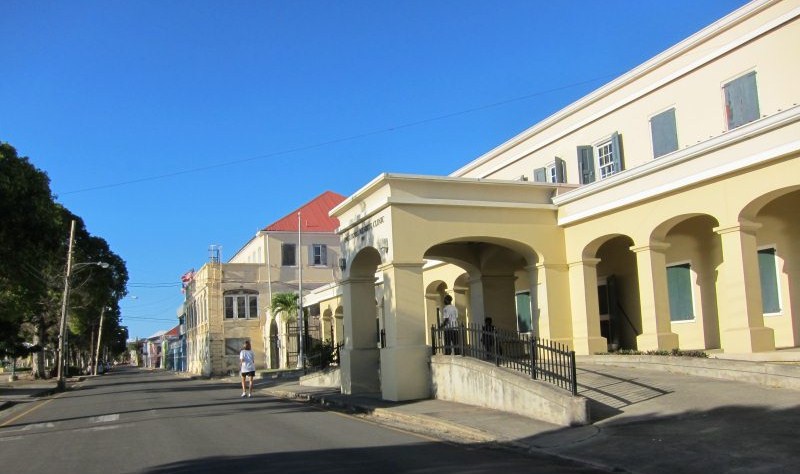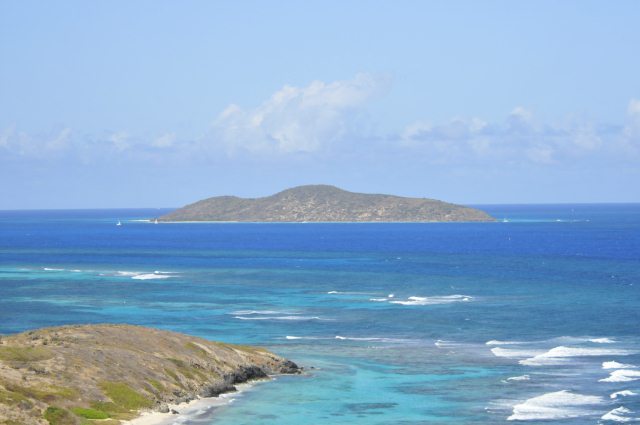St Croix

|
St Croix
Saint Croix (pronounced St Croy - NOT St Quar as many try to assume, just ask a local on a visit to be put right) is an island in the Caribbean Sea, and a county and constituent district of the United States Virgin Islands (USVI's), an unincorporated territory of the United States. It is the largest of the US. Virgin Islands at twenty eight miles by seven. However, the territory's capital, Charlotte Amalie, is located on Saint Thomas. Wherever you look from the island has spectacular views.

Salt River, where Columbus landed on the 14th of November 1493. GB pointing to the spot on the beach where he felt Columbus had rested his foot whilst claiming the land. Bear went off to take this snap of the sign and swears these are the shoes that Columbus was wearing at the time - I am making no comment at all.
 
History: Saint Croix has flown seven different flags. It has been colonised by Spain, Great Britain, the Netherlands, France, the Knights of Malta, Denmark and the United States. Before Christopher Columbus came over to the Caribbean, groups of indigenous people settled on the island in 5000 BC. They developed culture and religion, and called the island "Ay-Ay". These people did not make things out of ceramics, but used tools made of stone, shell, coral and bone. They ate shellfish and wild plant foods. Some time between 50 and 200 A.D., the Arawaken speaking people brought pottery and agriculture to the Caribbean. They lived in villages located near fertile soil planting manioc, beans, sweet potatoes and pineapple. The natives had trade routes in the Caribbean islands, which later expanded to South America. They traded gemstones, seafood and crops. In the 13th century, the Tanio people and Carib tribe (for whom the Caribbean is named) arrived from North, Central and South America. Tanio politics, religion and art were relatively developed. Arawaks and Caribs inhabited Saint Croix prior to European colonisation. Christopher Columbus visited on the 14th of November 1493 at the Salt River. Columbus called the island Santa Cruz ("Holy Cross"). His initial visit led to a battle in which one Spaniard and one Carib were killed, the first recorded violent confrontation between Europeans and indigenous peoples in the Americas. This heralded warfare between the Spaniards and Caribs which lasted for over a century, until the Spanish abandoned the island. In the seventeenth century, Dutch and English settlers, who soon came in conflict with one another, settled the island. Eventually the Dutch abandoned their settlement. Next, the English settlement was destroyed by the Spanish, who retook the island in 1650, they in turn were immediately ousted by the French.

The island was owned by the Knights of Malta after being bequeathed by Phillippe de Longvilliers de Poincy, governor of the French colony of St. Kitts in 1660. However, they sold it to the French West India Company five years later. Under Governor Dubois, the colony became profitable with over ninety plantations established, growing such crops as tobacco, cotton, sugar cane and indigo. After Dubois's death, the colony declined and Europeans abandoned the island until 1733 when it was sold to the Danish West India and Guinea Company. This company placed no national restrictions on colonists and soon attracted Spanish Sephardic Jews, Huguenots, and English settlers, the last of which came to dominate the island. Sugar cane became the major crop. Eventually, however, the development of the sugar beet in Europe undermined the economy of the colony. So this piece of Real Estate ended up as one of the USVI's. Slavery was abolished after a successful insurrection in 1848, but in 1862, St. Croix received a shipload of East Indians that were indentured on the island for five years. There was a labour revolt by former slaves in 1878 when much of Frederiksted, one of the island's two towns, was burnt in a labour revolt now known as the Fireburn. It was reportedly led by four women known as the "Queens" of the revolt, and a modern island thoroughfare is named after "Queen Mary" Thomas. In 1917, the Danish West Indies were sold by Denmark to the United States of America for $25 million in gold. The U.S. feared the island would fall into German hands and be used as a base for attacks against the United States and its interests in the western hemisphere. In return, the United States backed Denmark's claim to Greenland. On the 6th of September 1972, five masked men gunned down eight people at the Fountain Valley (now Carambola) Golf Course. While all involved were captured and convicted, the trial exposed deep racial tensions on St. Croix and devastated the island's tourism industry. There is a rumour that St Croix suffers much crime, certainly we saw nothing of the sort and never felt unsafe or threatened, in fact, quite the opposite.

St. Croix suffered major destruction on the 17th and 18th of September 1989 when Hurricane Hugo hit the island. The island then suffered a fair amount of damage during Hurricane Marilyn in September 1995. Hurricanes Georges, Lenny and Omar also struck the island in 1998, 1999 and 2008 respectively, but damage was minimal in comparison. There are still many buildings, especially on the outskirts of Christiansted, that still lie in ruins as a result of hurricanes, we saw some and was pleased workmen could be seen clearing and plans are in place for renovation. Although the US. Virgin Islands remain under the US. flag, the islands are an unincorporated territory with a non-voting delegate to the United States House of Representatives. Residents are U.S. citizens, but have no vote in national elections and generally do not pay taxes to the U.S. Internal Revenue Service, though taxes are paid, using U.S. law, to the U.S. Virgin Islands Bureau of Internal Revenue.
 Geography: There are two towns on the island; Christiansted with a 2004 population of 3,000 and Frederiksted with a 2004 population of 830. The total population of the island is about 60,000. The official 2000 census count was 53,234, living on a land area of 82.88 square miles. Inhabitants are called Crucians and English is the most common language. Spanish is spoken by the large Puerto Rican and smaller Dominican (Dominican Republic) populations, and a French Creole is spoken by the large St. Lucian and Dominican (Dominica) populations. A native English-based dialect known on the island as Crucian, but formally known as Virgin Islands Creole, is also spoken by the majority of the population in informal situations.

Fort Christiansvaern (own blog) built in 1749 and other buildings are maintained by the National Park Service as the Christiansted National Historic Site. St. Croix lies at the easternmost point in the United States -Point Udall. The island has an area of a little over eighty square miles. The terrain is rugged, though not extremely so. The highest point on the island, Mount Eagle, is 1,165 feet high. Most of the east end is quite hilly and steep, as is the north side from Christiansted west. From the north side hills, a fairly even plain slopes down to the south coast: this was the prime sugar land on the island. The trade wind blows more or less along the length of the island. The hills of the western part of the island receive a good deal more rain than the east end; annual rainfall is on the whole extremely variable, averaging perhaps forty inches a year. Fairly severe and extended drought has always been a problem, particularly considering the lack of fresh ground water and lack of freshwater streams, rivers, or bays on the island. The island does have a desalination plant however most residential homes and businesses have a built-in cistern used to collect rainwater.
We were next to the 'runway' on Beez of this local transport to St Thomas
ALL IN ALL LOVE IT HERE
|






